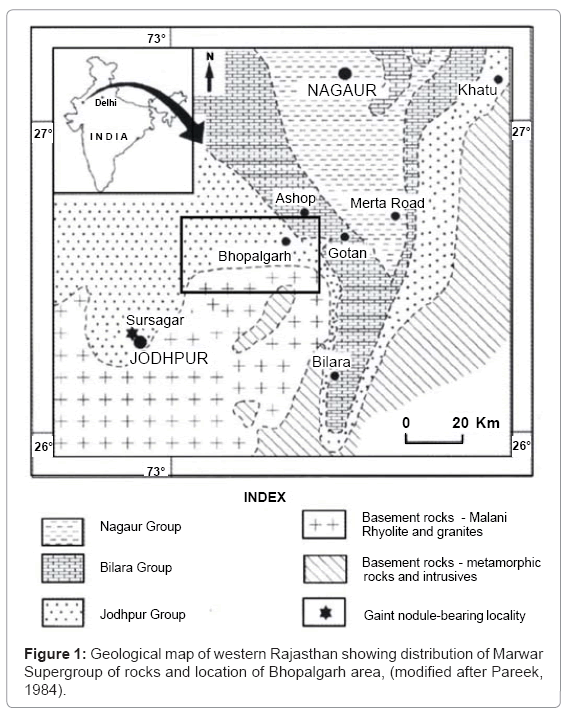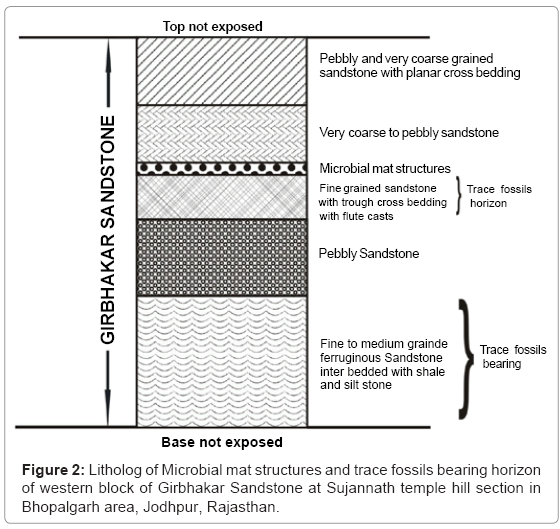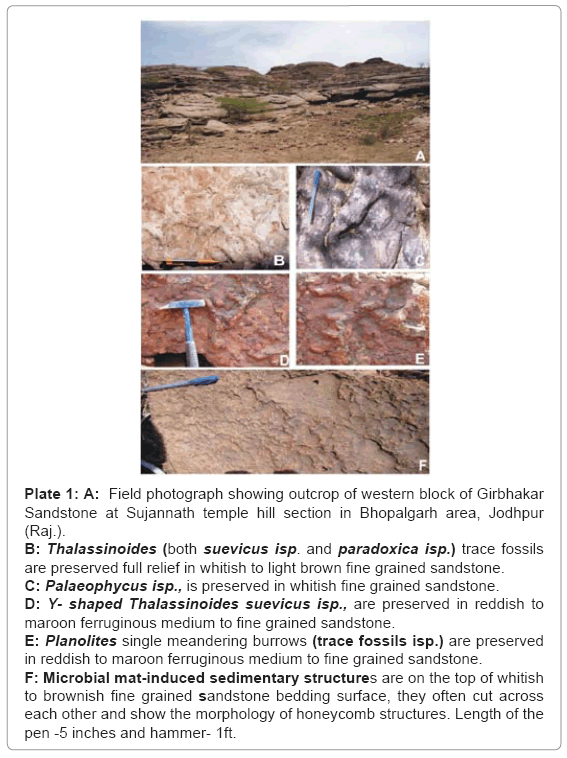Trace Fossils and Microbial Mat- Induced Sedimentary Structures from the Girbhakar Sandstone of Marwar Supergroup, Bhopalgarh Area, Jodhpur, Rajasthan, India
Received: 18-Aug-2012 / Accepted Date: 20-Aug-2012 / Published Date: 22-Aug-2012 DOI: 10.4172/2157-7617.S12-002
Abstract
Well-preserved trace fossils (Thalassinoides isp, Planolites isp. and Palaeophycus isp) and Microbial mat -induced sedimentary structures are reported from Girbhakar Sandstone of Marwar Supergroup, the upper sequence of Jodhpur Group. The trace fossils are preserved in fine grained sandstone and ferruginous sandstone, where as mat -induced sedimentary structures are, occur in patches on the top of fine grained sandstone bedding surface. The area under present investigation lies around Bhopalgarh, which is 70 km northeast of Jodhpur. All these ichnogenera shows marine and shallow marine to sub-tidal depositional environment. No age can be assigned on the basis of these trace fossils as they range from Cambrian to Recent but the presence of microbial mat-induced sedimentary structures are Ediacaran affinity and can be assigned Ediacaran age to Girbhakar Sandstone of Bhopalgarh area included in Girbhakar Sandstone Formation.
Keywords: Trace fossils; Microbial mat structures; Girbhakar sandstone; Marwar supergroup; Bhopalgarh; Jodhpur and Rajasthan
Introduction and Geology of the Study Area
Marwar Supergroup is a Late Neoproterozoic to Early Cambrian lithostratigraphic unit occupies a large area in north western Rajasthan which was deposited in various shallow marine to nonmarine environments [1]. It has been subdivided in three groups in stratigraphically ordered lower Jodhpur Group, middle Bilara Group and upper Nagaur Group, [2], where as Jodhpur and Nagaur Group’s are argillo -arenaceous sequences and Bilara Group is besically a calcareous lithounit. The complete lithounit of Marwar Supergroup is 1000m thick that is unconformably overlies on Ca.779 -681 Ma old Malani Igneous Suites [3,4] (Table 1). Biostratigraphy and palaeoecological conditions of Marwar Supergroup is still poorly known because body and trace fossils are very rare but recent studies shows that it yielded Microbial mat structures [5], Mega plant fossils, [6], Ediacaran medusoid associated with algal mats and trace fossils [7], Thalassinoides trace fossils Parihar [8], Trace fossils and microbial mat structures [8], five -armed body fossil [9]. The Early Cambrian trilobites trace fossils [10], provide more information about the stratigraphy of Marwar Supergroup. The lower sequence of Jodhpur Group named as Sonia Sandstone Formation are exposed in the quarries of Sursargar, Mandore, Kaliberi, Keru and Balesar areas whereas upper sequence of Jodhpur Group named as Girbhakar Sandstone Formation are exposed in Lohawat, Phalodi in northwest of Jodhpur and Mandalnath to Bhopalgarh areas in the northeast of Jodhpur (Figure 1). The area under present investigation lies around Bhopalgarh (N 26° 36’.063 : 073° 26’.413 E), which is 70 km northeast of Jodhpur and sandstones of the area represents the upper sequence of Jodhpur Group included in Girbhakar Sandstone Formation (Figure 2). The sandstone bodies of the area are divided into Eastern and Western Block. The sandstone with associated shale/mudstone of both the blocks is divided into five coeval lithostratigraphic units. There is mainly very coarse grained to coarse grained pebbly sandstone and medium grained sandstone consisting of trough cross bedding, plannar cross bedding in both eastern and western block. The lithologies of eastern block are fine grained sandstone, siltstone, shale, mudstone and chert, whereas fine grained sandstone, silstone, shale and flute marks are characteristics of western block [11].
| Marwar Supergroup (Late Neoproterzoic to Early Cambrian) |
Nagaur Group (75-500m) | Tunklian Sandstone Nagaur Sandstone | |
| Hanseran Group (upto 60m) | Clay stone, silt stone, dolostone, anhydrite, halite | ||
| Bilara Group (100-300m) | Pondlo dolomite Gotan limestone Dhanapa dolomite | ||
| Jodhpur Group (125-340m) | Girbhakar Sandstone /Formation | Buff, brownish, purplish to reddish white, spotted, gritty, pebbly, massive to thickly bedded sandstone and siltstone sequence. | |
| Sonia Sandstone/Formation Pokran Boulder Bed | |||
| ----------------------------Unconformity---------------------------------- | |||
| Basement | Malani Rhyolites and Granites | ||
Table 1: Stratigraphic succession of the Marwar Supergroup, Rajasthan (modified after Pareek, 1984).
Palaeontology
Trace fossils and Microbial mat structures: Three trace fossil species and Microbial mat-induced sedimentary structures have been reported from ferruginous sandstone, fine and medium grained sandstone of western block of Girbhakar Sandstone at Sujannath temple hill section in the Bhopalgarh area (Plate 1A). They are identified as Thalassinoides isp (Both Thalassinoides suevicus isp and Thalassinoides paradoxica isp.), Palaeophycus isp Planolites isp and Microbial mat -induced surface ridge (misr - a type of microbial mat induced sedimentary structure).
Plate 1: A: Field photograph showing outcrop of western block of Girbhakar Sandstone at Sujannath temple hill section in Bhopalgarh area, Jodhpur (Raj.).
B: Thalassinoides (both suevicus isp. and paradoxica isp.) trace fossils are preserved full relief in whitish to light brown fine grained sandstone.
C: Palaeophycus isp., is preserved in whitish fine grained sandstone.
D: Y- shaped Thalassinoides suevicus isp., are preserved in reddish to maroon ferruginous medium to fine grained sandstone.
E: Planolites single meandering burrows (trace fossils isp.) are preserved in reddish to maroon ferruginous medium to fine grained sandstone.
F: Microbial mat-induced sedimentary structures are on the top of whitish to brownish fine grained sandstone bedding surface, they often cut across each other and show the morphology of honeycomb structures. Length of the pen -5 inches and hammer- 1ft.
Systematic palaeontology
Thalassinoides isp, (Ehrenberg, 1944): In this area both species Y-shaped (Thalassinoides suevicus isp.) and T-shaped (Thalassinoides paradoxica isp) are found in whitish to brownish fine grained sandstone and reddish brown to maroon medium to fine grained ferruginous sandsone (Plates 1B and 1D). It is feeding or dwelling process, smooth wall tubes and displaying a network of triple junction. These tubes were filled with siliciclastic sediments. These species are known to be produced by decapods crustaceans and it shows shallow marine depositional environment.
Palaeophycus isp., (Hall, 1847): Palaeophycus isp is a single burrow that can show branching, is oriented horizontal or oblique to bedding, and has a distinctive burrow lining. It is found in whitish to light brown fine grained sandstone (Plate 1C). The burrow tubes were filled with siliciclastic matrix. It has length about 6-7 inches (Plate 1C). Palaeophycus is considered as a combined and dwelling burrow formed by worm like animals.
Planolites isp (Nicholson, 1873): It is single meandering burrows oriented horizontal or oblique to bedding, straight to gently curve are found in reddish brown to maroon medium to fine grained sandstone. The burrows were filled with sandy and silty matrix (Plate 1E). Planolites is interpreted as a feeding burrows made by worm like animals.
Microbial-mat structures: Here we report well-reserved linear, polygonal and spindle-shaped microbial mat-induced sedimentary structures from the whitish to brownish fine grained sandstone bedding surface in the Girbhakar sandstone at Sujannath temple hill section in Bhopalgarh area included in western block of Girbhakar Sandstone Formation. It is known as microbial mat-induced surface ridges (misr (a type of microbial mat induced sedimentary structure), except for the parallel ones, they often cut across each other and show the morphology of honeycomb structures (Plate 1F). These microbial mats-induced surface ridges (misr) are occur in patches on the top of brownish fine graind sandstone bedding surface. It is suggested that the mat-induced sedimentary structures were formed when the sand devoid of mud content was made cohesive by the presence of microbial mats. Detailed work is in progress.
Conclusion
(i). All these ichnogenera are well-preserved and shows marine and shallow marine to sub-tidal depositional environment [12,13].
(ii). No age can be assingned on the basis of these trace fossils as they range from Cambrian to Recent [14,15], but the presence of Microbial mat -induced sedimentary structures (Ediacaran affinity) and stratigraphic status (it’s overlies on Ediacaran Sonia Sandstone of Jodhpur Group) can be assingned Ediacaran age to Girbhakar Sandstone of the Bhopalgarh area.
References
- Pandey DK, Bahadur T (2009) A Review of the Stratigraphy of Marwar Supergroup of west- central Rajasthan. Geol Soc India 73: 747-758.
- Pareek HS (1984) Pre-Quaternary geology and mineral resources of north- western Rajasthan. Mem Geol Surv India 115: 99.
- Rathore SS, Venkatesan TR, Shrivastava RC (1999) Rb-Sr isotope dating of Neoproterozoic (Malani group) magmatism from southwest Rajathan, India: evidence of younger Pan –African thermal event by 40Ar- 39Ar studies. Gondwana Research 2: 271-281.
- Roy AB, Jakhar S (2002) Geology of Rajasthan (North West India) Precambrian to Recent. Scientific Publishers (India) Jodhpur 421.
- Sarkar S, Bose PK, Samanta P, Sengupta P, Erikssion G (2008) Microbial mat mediated structures in the Ediacaran Sonia sandstone, Rajasthan, India and their implications for Proterozoic sedimentation. Precambrian Research 162: 248-263.
- Kumar S, Mishra MK, Pandey SK (2009) Ediacaran megaplant fossils with Voucheriacean affinity from the Jodhpur sandstone, Marwar Supergroup, western Rajasthan. Current Science 97: 701-705.
- Raghav KS, De C, Jain RL (2005) The first record of Vendian medusoids and trace fossils-bearing algal matgrounds from the basal part of the Marwar Supergroup of Rajasthan, India. Indian Min 59: 23-30.
- Parihar VS, Gaur V (2012) Trace fossils and microbial mat-induced sedimentary structures from the girbhakar sandstone of marwar supergroup, Bhopalgarh area, Jodhpur, Rajasthan, India. International Conference on Earth Science and Climate Change, Hilton Chicago/ Northbrook, USA.
- Kumar S, Srivastava DK, Ahmad S (2012) Five-armed body fossil from Ediacaran Jodhpur Sandstone, Marwar Supergroup, western Rajasthan, India: a possible precursor of phylum Ecinodermata. Curr Sci India 102: 24-26.
- Kumar S, Pandey SK (2010) Trace fossils from the Nagaur Sandstone, Marwar Supergroup, Dulmera Area, Bikaner district, Rajasthan, India. J Asian Earth Sci 38: 77-85.
- Narayan Ram, Chauhan DS (2007) The Jodhpur sandstone of Bhopalgarh area: Its geological nature and environment of deposition. Emerging trends of research in Geology (NW INDIA) ed. Avadich PC, Bhu H: 89-103.
- Frey RW, Seilacher A (1980) Uniformity in marine invertebrate ichnology. Lethaia 13: 183-207.
- Hanntzschel W (1975) Trace fossils and problematica. Treatise on invertebrate paleontology, part W, miscellanea supp. Geological Society of America and University of kanas Press, Lawrence: 1-269.
- Wetzel A (1983) Biogenic sedimentary structures in a modern upwelling region, northwest African continental margin. Coastel upwelling and its sedimentary record, Part B; sedimentary record of ancient coastal upwelling, New York (Plenum): 123-144.
Citation: Parihar VS, Gaur V, Nama SL (2012) Trace Fossils and Microbial Mat- Induced Sedimentary Structures from the Girbhakar Sandstone of Marwar Supergroup, Bhopalgarh Area, Jodhpur, Rajasthan, India. J Earth Sci Climat Change S12: 002. Doi: 10.4172/2157-7617.S12-002
Copyright: ©2012 Parihar VS, et al. This is an open-access article distributed under the terms of the Creative Commons Attribution License, which permits unrestricted use, distribution, and reproduction in any medium, provided the original author and source are credited.
Share This Article
Open Access Journals
Article Tools
Article Usage
- Total views: 15321
- [From(publication date): 0-2013 - Apr 19, 2024]
- Breakdown by view type
- HTML page views: 10928
- PDF downloads: 4393



